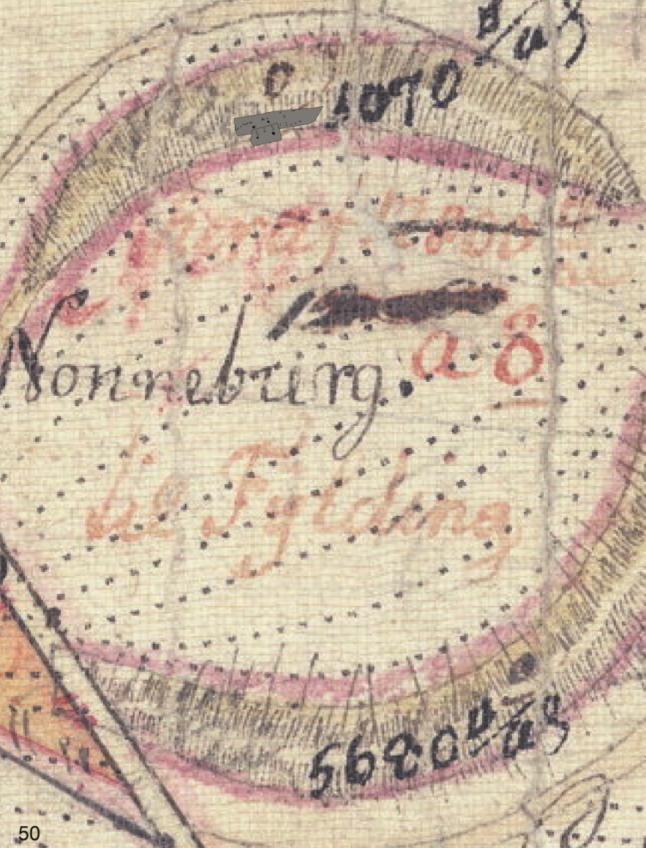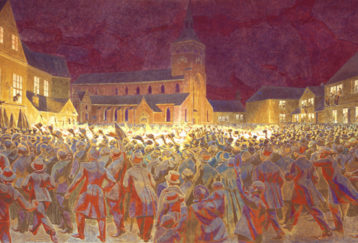
The history of literary and philosophical thought in Georgia took shape centuries ago. Traces of the highly developed culture of the Georgian (Kartvelian) tribes can be found in Georgian, as well as Greek mythology. It can be supposed that the first information about Georgia penetrated into Western Europe through Greek sources.
The history of original Georgian literature begins in the fifth century and reaches the peak of its development in the 12th century. Contacts with foreign countries were greatly favoured by the geographical position of Georgia – situated as it is, at the meeting point of the European and Asian parts of the Continent, Georgia developed its cultural and literary contacts with other countries. On the other hand, participating in the world cultural and literary processes with its original literature, Georgia contributed, for its part, to the treasury of world culture. By the beginning of the 12th century nearly all the important written records of Byzantine literature had been translated into Georgian. These translations are very important nowadays, as their Greek originals are lost and they are being restored now on the basis of the Georgian translations.
The Renaissance of Georgian literature in the 12th century was conditioned by the development of Arabic literature the so-called »Moslem Renaissance«.
Like pre-Renaissance European thinking, Georgian literature of the 12th cent. became imbued with humanistic ideas, a human being with its earthly ideals came into the foreground. The final development of this trend occurs in the poem The Man in Panther’s Skin by Shota Rustaveli.
Judging from the works published on Georgian-European cultural contacts from the Middle Ages onwards, Western Europe displayed a certain interest in Georgia. The orientation of Georgian social and political thought towards Europe, so characteristic of the old Georgian cultural life, ceased in the second half of the 13th cent., as a result of the political catastrophe in the Georgian State.
At the end of the 18th century the permanent struggle of Christian Georgia with the Moslem East ended with the intervention of Russia. Since that period Russian and Western European contacts acquired vital importance for Georgian culture.
European orientation left its mark on the literary relations of Georgia. From the second half of the 19th century cultural and literary relations between Europe and Georgia became systematic.
Hans Christian Andersen’s name was known in Georgian literary life from the 1870’s. From that time the first information about the great Danish writer appeared in Georgian press. Andersen’s creative work was perceived in two ways – by translations and literary criticism.
Georgian readers generally know Andersen as a great tale-writer, the winner of both: children’s and grown-ups’ hearts. Children’s magazines, such as – Jejili (»Cornfield«), Nobati (»Gift«), Nakaduli (»Streamlet«), Nakaduli Mozrdiltatvis (»Streamlet for Grown-ups«)… payed attention to Andersen’s fairy tales from the very beginning. Some of the early translations are Georgian variants of the fairy tales, in which sometimes Geogian proper and place names are used, the titles are changed, etc. e.g. the title of the fairy tale Big Claus and Small Claus in E. Meskhi’s (1854-1928), well-known Georgian translator, translation is called Big and Small Giorgi (Giorgi is a Georgian name and it corresponds to European George). It was published in the journal Nobati (»Gift«), 1884, N10-11-12. One of the fairy tales in E. Gulisashvili’s translation, is called The Camomile. It was published in the book Illustrated Stories for Children, Tbilisi, 1911. It is a collection of translations from different foreign writers’ works. The same tale in V. Mikaberidze’s translation is entitled The Camomile and the Lark (printed in the journal Jejili »Cornfield«, 1905, N12). Such alterations are not only Georgian translators’ faults. The translations aren’t done from the originals and the lack of adequacy of translations in some cases is the result of double transformation. In the old newspapers and magazines some other translations of Andersen’s fairy tales are also published: Pen and Ink, newspaper Iveria, 1893, N143. The translator wrote his pseodonym »Or-Ani«; Mother translated by S. Gongadze (journal Jejili »Cornfield«, 1894, N5); in 1896 there was published the book -H.C. Andersen, Fairy Tales, translated by Nino Nakashidze (1872-1963), Georgian public figure, children’s writer and translator. There are two fairy tales there – Fir-tree and A Pig Tender, in 1897 there was published the book Swans and in 1900 the book Mother translated from French by outstanding Georgian translator Tedo Sahokia (1868-1956); a tale of poor little Hans, entitled Cripple, translated by S. Tsitsishvili (journal Jejili »Cornfield«, 1905, N3,4); Ugly Duckling translated by N. Nakashidze (journal Nakaduli Mozrdil-tatvis »Streamlet for Grownups, 1905, N4). In the book Fairy Tales, published in 1920, two new translations of H.C. Andersen’s fairy tales are printed: The Inch-girl and Cranes. They are translated by Georgian public figure, writer and literary critic Ilia Nakashidze (1866-1923). The name of the painter is not mentioned in the book, but there are black and white illustrations there. All above-mentioned translations except T. Sahokia’s books are done from Russian.
Modern translations of Hans Christian Andersen’s fairy tales are of higher literary value, the writer’s fantastic world is rendered more carefully.
To the sesquicentennial anniversary of H.C. Andersen was dedicated the book Fairy Tales, Tbilisi, 1956.
The book contains fifteen selected fairy tales. Some of them were taken from early translations. Most of them were done specially for this edition. The content is as follows: Swans – translated by Tedo Sahokia. The first version was published in 1897. Ugly Duckling – translated by Nino Nakashidze. The first version was published in 1905. A Very Small One – translated by Ilia Nakashidze. The first version of this tale – The Inch Girl, as I have already mentioned, was published in 1920. In this edition the title is a bit changed. Because I. Nakashidze was not alive in 1956, I think that this small change was done by his wife Nino Nakashidze. The Emperor’s New Clothes – translated from English by outstanding Georgian writer and translator Vahtang Che-lidze (1917). Die Nachtigall – translated from German by well-known Georgian linguist, professor Shota Dzidziguri (1911). Die Prinzessin auf der Erbse, Der Shatten and Ein Unterschied ist da were translated from German by the well-known Georgian translators, the brothers Carlo Jorjaneli (1925) and Giorgi Jorjaneli (1927-1986). The Flying Box, A Big Needle And The Tinder and Fire – were translated from Russian by Georgian journalist Platon Bebia (1925-1975). Tölpel-Hans, Der kleine Klaus und der große Klaus, Das kleine Mädchen mit den Schwefelhölzchen and Der Schweinehirt were translated from German by Akaki Chkadua. Here I must note, that Akaki Chkadua and Akaki Gelovani (1928) is one and the same person. His real name is Gelovani, but in his early works he signed as Chkadua. He is a Georgian writer and translator. The illustrator of the book is V. Beletskaia (1925). The cover of the book is coloured, illustrations are black and white.
The next edition is – Hans Christian Andersen, Swans, Tbilisi, 1962. It is reprinted from the first version translated by Tedo Sahokia. Black and white Illustrations are done by a great Georgian sculptor and artist Merab Berdze-nishvili (1929). The cover of the book is coloured.
The following edition is Hans Christian Andersen, The Inch-girl, Tbilisi, 1970. It is translated from Russian by Mariam Chavchanidze. The illustrator is Victor Chumburidze. The illustrations are coloured.
In 1971 the Georgian translations of Hans Christian Andersen’s 34 fairy tales were published. The title of this book is The Snow Queen.
Those translations were done by Georgian translator Akaki Gelovani from German. The book contains following tales: Das Feuerzeug; Der kleine Klaus und der große Klaus; Die Prinzessin auf der Erbse; Die Blumen der kleinen Ida; Die kleine Seejungfrau; Der standhafte Zinnsoldat; Der fliegende Koffer; Der Schweinehirt; Eine Rose vom Grabe Homers; Die Nachtigall; Die Schneekönigin; Die Springer; Das kleine Mädchen mit den Schwefelhölzchen; Der Wassertropfen; Die Mutter; Holger von Dänemark; Die Hirtin und der Schornsteinfeger; Das Schwanennest; »Es ist ganz gewiß!«; Tölpel-Hans; Der Wind erzählt von Waldemar Daae und seinen Töchtern; Die Glocke; Kinderschnack; Was Vater tut, ist immer recht; Bischof von Börglum; Der böse Fürst; Vähö und Glänö; Ein Mensch findet alles; Der Meer-drakon; Der Gärtner und die Herrschaft; Das versunkene Kloster; Diese Fabel ist für dich; Der Talisman; Der arme Knabe auf dem Trone Frankreichs.
As it was already mentioned these translations are done from German. But the translator told me that for some details he also used the Danish edition: H.C. Andersen, Eventir [sic] og Historier, I, II, Cayldendal [sic], 1957. The introduction about Hans Christian Andersen’s life and creative work is written by the translator A. Gelovani. The book is illustrated in black and white by Georgian painter J. Tsindeliani (1933). There is H.C. Andersen’s portrait and at the beginning of every tale there are ornaments.
In 1976 there was published another book by Andersen with the same title The Snow Queen. It contains A. Gelovani’s translations – Die Schneekönigin, Der Schwänehirt, Das Feuerzeug and N. Nakashidze’s translation Ugly Duckling. The coloured illustrations belong to the great Georgian artist Zurab Nizha-radze (1928). There is the third book which is called The Snow Queen. It contains only this fairy tale, translated from German by Akaki Gelovani. The painter is Georgian – Manana Ebralidze (1936). The illustrations are coloured.
Thus, as we have seen, some of the fairy tales are translated several times by the different translators (e.g. Big Claus and Small Claus, The Tinder and Fire, The Flying Box, The Nightingale, Mother, The Camomile and the Lark, etc.). Some of the translations are published several times (e.g. Swans, Ugly Duckling, The Inch-girl, The Stupid Hans, The Snow Queen, etc.). I want to mention here that the translations are mostly done by well-known translators.
All this is the manifestation of the interest and respect of the Georgian people to Hans Christian Andersen.
Now a few words about H.C. Andersen in Georgian literary criticism.
Andersen’s biography was first published in Georgia in the magazine Nakaduli Mozrdiltatvis (»Streamlet for Grown-ups«, 1905, N12). The author wrote by the pseodonym »Uncle Valiko«. From the very beginning the reviews about some translations were also published in Georgian press, (e.g. In the newspaper Tsnobis Purtseli »Information Sheet«, 1897, N352, was the review about the book translated by N. Nakashidze the year before. In the same newspaper of the same year N165, was the review about the book Swans translated by T. Sahokia, etc.). In the scholarly articles Andersen’s life is mainly divided in two parts – hard childhood and interesting and happy years of manhood, when the people of different nations loved him. It is mentioned, that in Georgia we already have the translations of H.C. Andersen’s fairy tales but it is necessary to translate and publish all the 156 fairy tales.
Besides biographies and scholarly works, small bits of information were also published in Georgian press during the writer’s lifetime. One of these runs thus: the newspaper Droeba (»Times«, 1875, N14) writes, that American children had information that their favourite writer Andersen lived in poverty. That’s why they decided to gather money and send it to him, but they got Andersen’s letter where he thanked them and wrote that his work was appreciated by the government of Denmark and they gave money to him. The people were going to erect his monument during Andersen’s life. Or, the writer Ilia Nakashidze in the newspaper Tsnobis Purtseli (»Information Sheet«, 1904, N2640) criticized the young generation – described the different pictures of life and mentioned Andersen’s fairy tale Fir-tree where together with the poetry of life the prose of life is described.
By using the different aspects of Andersen’s life and creative work many interesting works are made from the 1950’s.
In 1955, when H.C. Andersen’s 150th anniversary was celebrated by the decision of World’s Council of Peace, the Georgians also marked this date. Scholarly session was held, on which the Georgian scholars and literary researchers showed H.C. Andersen’s great contribution to the world literature. Akaki Chkadua’s (Gelovani) book Great Danish Writer Hans Christian Andersen (Tbilisi, 1956) was dedicated to this date. In this book Andersen’s creative work is analysed alongside with his whole life – there is an interesting narration about his life which was compared with the fairy tale by the writer himself in his autobiographic book The Fairy Tale of my Life. A. Chka-dua relates about the great humanist’s hard childhood, which according to Andersen, would give much information to Dickens in describing poor children’s life. The author of the book points to the high value of Andersen’s novels and poetry, but he considers that he became famous by his fairy tales, because they are created on the national basis, using old Danish folklore. Beautiful nature of Denmark, Danish traditions are described, great humanism is given there and all these are related lively using Andersen’s syntax and sharp humour. He is a wonderful sucessor of Heine, the brothers Grimm, Hopman, and he is a great master of the realistic fairy tale, in which two ideas can be noticed – for children and for grown-ups.
Akaki Chkadua speaks about the writer’s popularity in Europe, describes his friendship with the well-known writers and musicians – Hugo, Balsac, Dumas-father, Grimm, Wagner, Schumann, Rossini, Liszt, Mendelsohn… So, this small book gives a clear view to Georgian readers about Andersen’s world.
In the newspaper Literaturuli Gazeti (»Literary Newspaper«, 1955, N13), professor of literature Alexandre Gvaharia wrote an article dedicated to the 150th anniversary of the »Great Tale-writer«, where he is remembered with great love and respect.
In 1963 »From the Series of Well-known People«, the volume Hans Christian Andersen appeared, translated from Russian. The author of the Russian text is Irina Muraviova. The Georgian translation is done by Militsa Abashidze. In this book light is shed on Andersen as a tale-writer with the help of his own creative work, an attempt is made to imagine him as he is seen from his fairy tales. The autobiographic letters, the diaries, the works of Russian and Danish scholars are used in this book.
Russian author Constantine Paustovski’s remembrance-story The Tale-writer was translated into Georgian by a journalist V. Dzidziguri (1926) and published in the newspaper Literaturuli Sakartvelo (»Literary Georgia«, 1986, N34). Paustovski remembers how he first met Hans Christian Andersen. »This happened in the winter evening, when few hours were left till the beginning of the 20th century. Gay Danish tale-writer met me in the new threshold of the new century«. Paustovski’s mother put H.C. Andersen’s book of fairy tales at the New-Year tree for her 7 years old son. Then the writer remembers how gradually he adopted Andersen’s fantastic world, his biography, and describes Andersen’s journeys and his meetings with the great writers and composers of the 19th century and at the end mentions that besides the unhappy life he still remained very happy.
This nice essay is also reprinted in C. Paustovski’s book Well-known People, which was also translated into Georgian by V. Dzidziguri in 1987. Besides The Tale-writer the book contains Paustovski’s attitude, his impressions and feelings towards Russian painters Orest Kiprenski and Isaak Levitan, Ukrainian writer Taras Shevchenko, Russian writers Michale Lermontov and Arkadi Gaidar and Geogian artist Nicko Pirosmani.
After visiting H.C. Andersen Museum in Odense in July 1991, I published an article Hans Christian Andersen and his Fairy World in the newspaper Tbili-sis Universiteti (»Tbilisi University«, 1991, N21-22), where I told Georgian readers about this nice Museum, its aim and work, Andersen’s memorial places, my meeting and very interesting dialogue with the director of the Museum and the editor of the academic journal Anderseniana Niels Oxen-vad, and my great impression of the devoted work of Andersen experts who do much for immortalizing the name and heritage of H.C. Andersen.
So, Andersen’s Fairy tales are well-known among Georgian readers and it’s more than a century that they have been translating them and perceiving his fantastic world.
My stay in Denmark was full of pleasure and interest. I’d like to express my deep gratitude to Birgit and Finn Nerland who invited me to Denmark and arranged my visit to H.C. Andersen Museum.


